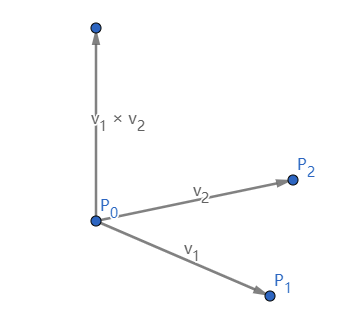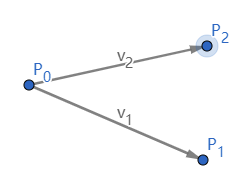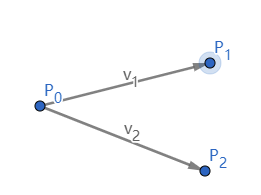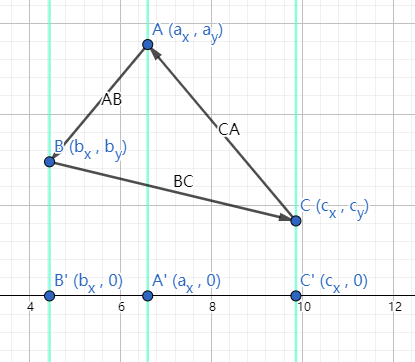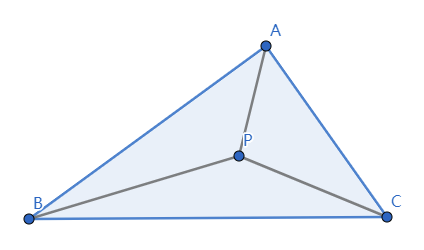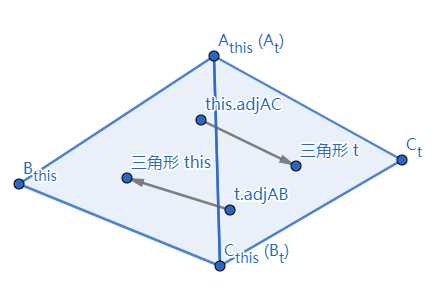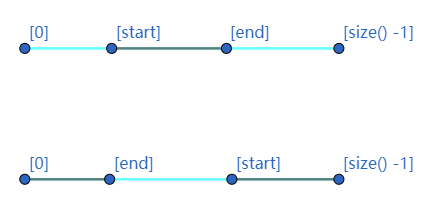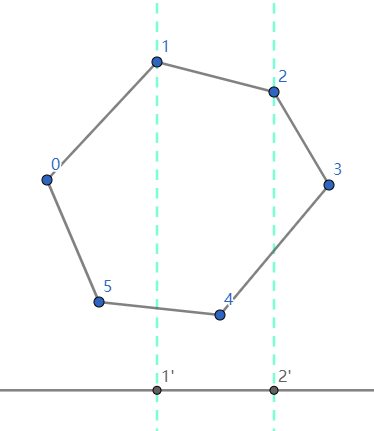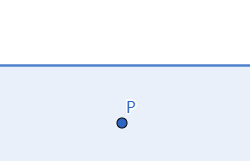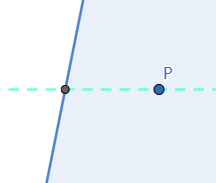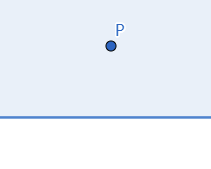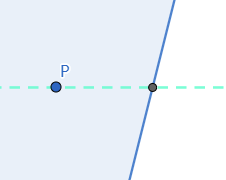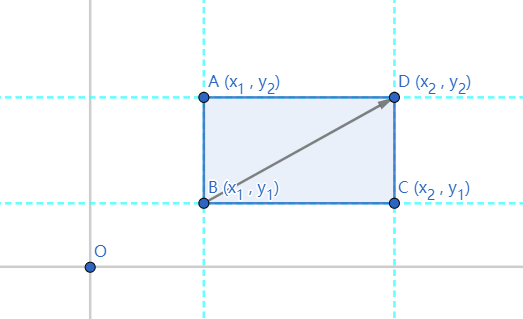$P_1 \to segment \gets P_2 $
1 2 3 4 5 6 7 final private double x;final private double y; private Segment segment;public final static Point NaP = new Point(Double.NaN, Double.NaN);
将线段附加到该点。
1 2 3 public void setSegment (Segment segment) this .segment = segment; }
计算叉积
两个由三个点 p0、p1 和 p2 定义的向量 (p0, p1) 和 (p0, p2)
1 2 3 4 private static double crossProduct (Point p0, Point p1, Point p2) return (p1.getX() - p0.getX()) * (p2.getY() - p0.getY()) - (p2.getX() - p0.getX()) * (p1.getY() - p0.getY()); }
定义:
{ v 1 ⃗ = ( P 0 , P 1 ) v 2 ⃗ = ( P 0 , P 2 ) \begin{cases}
\vec{v_1} = (P_0,&P_1) \\
\vec{v_2} = (P_0,&P_2)
\end{cases}
{ v 1 = ( P 0 , v 2 = ( P 0 , P 1 ) P 2 )
v 1 ⃗ × v 2 ⃗ = ∣ v 1 x ⃗ v 2 x ⃗ v 1 y ⃗ v 2 y ⃗ ∣ = ∣ ( p 1 x − p 0 x ) ( p 2 x − p 0 x ) ( p 1 y − p 0 y ) ( p 2 y − p 0 y ) ∣ \vec{v_1} \times \vec{v_2} =
\begin{vmatrix}
\vec{v_{1x}} & \vec{v_{2x}} \\
\vec{v_{1y}} & \vec{v_{2y}}
\end{vmatrix}
= \begin{vmatrix}
(p_{1x} - p_{0x}) & (p_{2x} - p_{0x}) \\
(p_{1y} - p_{0y}) & (p_{2y} - p_{0y})
\end{vmatrix}
v 1 × v 2 = ∣ ∣ ∣ ∣ v 1 x v 1 y v 2 x v 2 y ∣ ∣ ∣ ∣ = ∣ ∣ ∣ ∣ ( p 1 x − p 0 x ) ( p 1 y − p 0 y ) ( p 2 x − p 0 x ) ( p 2 y − p 0 y ) ∣ ∣ ∣ ∣
计算该点到另一点的距离。
1 2 3 4 public double dist (Point p0) return Math.sqrt((this .getX() - p0.getX()) * (this .getX() - p0.getX()) + (this .getY() - p0.getY()) * (this .getY() - p0.getY())); }
确认向量<p0, p1> 到 <p0, p2>是否为左转(右手坐标系下,逆时针旋转)
1 2 3 public static boolean isLeftTurn (Point p0, Point p1, Point p2) return (crossProduct(p0, p1, p2) > 0 ); }
确认向量<p0, p1> 到 <p0, p2>是否为右转(右手坐标系下,顺时针旋转)
1 2 3 public static boolean isRightTurn (Point p0, Point p1, Point p2) return (crossProduct(p0, p1, p2) < 0 ); }
确定该点是否为附加线段的左顶点。
1 2 3 public boolean isLeft () return (segment != null && this .equals(segment.getLeft())); }
确定该点是否为附加线段的右顶点。
1 2 3 public boolean isRight () return (segment != null && this .equals(segment.getRight())); }
确定该点是否等于 Point.NaP
1 2 3 public boolean isNaP () return x == Double.NaN || y == Double.NaN; }
一个线段的左右端点
1 2 final private Point left;final private Point right;
1 2 3 4 5 6 7 8 9 10 11 12 13 14 public Segment (Point left, Point right) if (left.getX() > right.getX()) { Point temp = right; right = left; left = temp; } left.setSegment(this ); right.setSegment(this ); this .left = left; this .right = right; }
返回线段的二等分中点坐标。
1 2 3 4 public Point getBisectionalPoint () return new Point((left.getX() + right.getX()) / 2 , (left.getY() + right.getY()) / 2 ); }
返回线段所在的直线。
1 2 3 public Line getLine () return new Line(left, right); }
用三个系数表示一条线a、b 和 c,其中 ax + by + c = 0。
1 2 3 4 5 6 7 8 9 10 11 12 13 14 15 16 17 18 19 public Line (double a, double b, double c) this .a = a; this .b = b; this .c = c; } public Line (Point p1, Point p2) this .a = p1.getY() - p2.getY(); this .b = p2.getX() - p1.getX(); this .c = p1.getX() * p2.getY() - p2.getX() * p1.getY(); } public Line (Segment s) this (s.getLeft(), s.getRight()); }
定义:
{ a = p 1 y − p 2 y b = p 2 x − p 1 x c = p 1 x ⋅ p 2 y − p 2 x ⋅ p 1 y \begin{cases}
a = p_{1y} - p_{2y} \\
b = p_{2x} - p_{1x} \\
c = p_{1x} \cdot p_{2y} - p_{2x} \cdot p_{1y}
\end{cases}
⎩ ⎪ ⎨ ⎪ ⎧ a = p 1 y − p 2 y b = p 2 x − p 1 x c = p 1 x ⋅ p 2 y − p 2 x ⋅ p 1 y
通过直线上某点的 Y 坐标计算它的 X 坐标
1 2 3 public double XforY (double y) return (-c - b*y) / a; }
定义:
x = − c − b ⋅ y a x = \frac {-c - b \cdot y} {a}
x = a − c − b ⋅ y
通过直线上某点的 X 坐标计算它的 Y 坐标
1 2 3 public double YforX (double x) return (-c - a*x) / b; }
定义:
y = − c − a ⋅ x b y = \frac {-c - a \cdot x} {b}
y = b − c − a ⋅ x
判断某点是否位于直线上。
1 2 3 public boolean pointOnLine (Point p) return (a*p.getX() + b*p.getY() + c == 0 ); }
确定直线是否递增
1 2 3 public boolean isAscending () return (b == 0 || (-a/b) >= 0 ); }
确定直线是否垂直
1 2 3 public boolean isVertical () return (b == 0 && a != 0 ); }
确定直线是否递减
1 2 3 public boolean isDescending () return (b == 0 || (-a/b) < 0 ); }
确定直线是否水平
1 2 3 public boolean isHorizontal () return (a == 0 && b != 0 ); }
判断直线是否为“未定义”(Undefined)
1 2 3 public boolean isUndefined () return (a == 0 && b == 0 && c == 0 ); }
以 X 轴的正方向,计算直线形成的角度
1 2 3 4 5 6 7 8 9 public double getAngle () if (isVertical()) return Math.PI/2 ; double arctan = Math.atan(-a/b); if (arctan < 0 ) arctan += Math.PI; return arctan; }
通过给定点计算垂直线。
1 2 3 public Line getPerpendicularLine (Point p) return new Line(this .b, -this .a, -this .b*p.getX() + this .a*p.getY()); }
定义:
{ A = b B = − a C = − b ⋅ p x + a ⋅ p y \begin{cases}
A = b \\
B = - a \\
C = - b \cdot p_x + a \cdot p_y
\end{cases}
⎩ ⎪ ⎨ ⎪ ⎧ A = b B = − a C = − b ⋅ p x + a ⋅ p y
垂线:
b ⋅ x − a ⋅ y − b ⋅ p x + a ⋅ p y = 0 b \cdot x - a \cdot y - b \cdot p_x + a \cdot p_y = 0
b ⋅ x − a ⋅ y − b ⋅ p x + a ⋅ p y = 0
确定点是否位于直线的左半部分
1 2 3 public boolean isLeftPoint (Point p) return p.getX() < XforY(p.getY()); }
确定点是否位于直线的右半部分
1 2 3 public boolean isRightPoint (Point p) return p.getX() > XforY(p.getY()); }
计算两条直线的交点。
1 2 3 4 5 6 7 8 9 public static Point intersection (Line l1, Line l2) if ((l1.a*l2.b - l2.a*l1.b) == 0 ) return Point.NaP; double x = (l1.b*l2.c - l2.b*l1.c) / (l1.a*l2.b - l2.a*l1.b); double y = (l2.a*l1.c - l1.a*l2.c) / (l1.a*l2.b - l2.a*l1.b); return new Point(x, y); }
定义:
{ L 1 : a 1 x + b 1 y + c 1 = 0 L 2 : a 2 x + b 2 y + c 2 = 0 ⇒ { x = b 1 c 2 − b 2 c 1 a 1 b 2 − a 2 b 1 y = a 2 c 1 − a 1 c 2 a 1 b 2 − a 2 b 1 \begin{cases}
L_1 : a_1x + b_1y + c_1 = 0 \\[3ex]
L_2 : a_2x + b_2y + c_2 = 0
\end{cases}
\Rightarrow
\begin{cases}
x = \frac {b_1c_2 - b_2c_1} {a_1b_2 - a_2b_1} \\[3ex]
y = \frac {a_2c_1 - a_1c_2} {a_1b_2 - a_2b_1}
\end{cases}
⎩ ⎪ ⎨ ⎪ ⎧ L 1 : a 1 x + b 1 y + c 1 = 0 L 2 : a 2 x + b 2 y + c 2 = 0 ⇒ ⎩ ⎪ ⎨ ⎪ ⎧ x = a 1 b 2 − a 2 b 1 b 1 c 2 − b 2 c 1 y = a 1 b 2 − a 2 b 1 a 2 c 1 − a 1 c 2
唯一解 :分母 ( a 1 b 2 − a 2 b 1 ) (a_1b_2 - a_2b_1) ( a 1 b 2 − a 2 b 1 ) 无解 :分母为零,两条直线平行。无穷多解 :分母为零,两条直线重合。
1 2 3 4 5 6 7 8 9 10 11 protected Point a, b, c;protected Triangle adjAB, adjBC, adjAC;private Object tag;
1 2 3 4 5 6 7 8 9 10 11 12 13 14 15 16 17 18 19 20 21 22 23 24 25 26 27 28 29 public enum Side AB(0 ), BC(1 ), AC(2 ); Side(int i) { this .i = i; } public static Side valueOf (int i) switch (i) { case 0 : return AB; case 1 : return BC; case 2 : return AC; default : return null ; } } int i; }
1 public class Triangle implements Cloneable
仅做浅复制,初始化三个指针
1 2 3 4 5 6 7 8 9 10 11 @Override public Object clone () Triangle res = (Triangle)super .clone(); return res; }
通过其顶点初始化三角形。
1 2 3 4 5 6 7 8 9 10 11 12 13 14 15 16 17 18 19 20 21 22 23 public Triangle (Point A, Point B, Point C) a = A; b = B; c = C; adjAB = adjAC = adjBC = null ; double sum = (b.getX() - a.getX())* (b.getY() + a.getY()) + (c.getX() - b.getX())* (c.getY() + b.getY()) + (a.getX() - c.getX())* (a.getY() + c.getY()); if (sum > 0 ) { Point temp = a; a = b; b = temp; } }
△ A B C \triangle ABC △ A B C
有符号面积 :若边的端点从左至右,则面积为正;若边的端点从右至左,则面积为负
NOTE :其中 S 梯 C C ′ A ′ A S_{梯CC'A'A} S 梯 C C ′ A ′ A
S 梯 C C ′ A ′ A = − 1 2 ( c x − a x ) ( c y + a y ) = 1 2 ( a x − c x ) ( c y + a y ) \begin{aligned}
S_{梯CC'A'A} &= - \frac {1} {2} (c_x - a_x)(c_y + a_y) \\
&= \frac {1} {2} (a_x - c_x)(c_y + a_y)
\end{aligned}
S 梯 C C ′ A ′ A = − 2 1 ( c x − a x ) ( c y + a y ) = 2 1 ( a x − c x ) ( c y + a y )
可得:
{ S 梯 A A ′ B ′ B = 1 2 ( b x − a x ) ( b y + a y ) S 梯 B B ′ C ′ C = 1 2 ( c x − b x ) ( c y + b y ) S 梯 C C ′ A ′ A = 1 2 ( a x − c x ) ( c y + a y ) \begin{cases}
S_{梯AA'B'B} = \frac {1} {2} (b_x - a_x)(b_y + a_y) \\
S_{梯BB'C'C} = \frac {1} {2} (c_x - b_x)(c_y + b_y) \\
S_{梯CC'A'A} = \frac {1} {2} (a_x - c_x)(c_y + a_y)
\end{cases}
⎩ ⎪ ⎨ ⎪ ⎧ S 梯 A A ′ B ′ B = 2 1 ( b x − a x ) ( b y + a y ) S 梯 B B ′ C ′ C = 2 1 ( c x − b x ) ( c y + b y ) S 梯 C C ′ A ′ A = 2 1 ( a x − c x ) ( c y + a y )
即:
S △ A B C = S 梯 A A ′ B ′ B + S 梯 B B ′ C ′ C + S 梯 C C ′ A ′ A = 1 2 [ ( b x − a x ) ⋅ ( b y + a y ) + ( c x − b x ) ⋅ ( c y + b y ) + ( a x − c x ) ⋅ ( a y + c y ) ] \begin{aligned}
S_{\triangle ABC} &= S_{梯AA'B'B} + S_{梯BB'C'C} + S_{梯CC'A'A} \\
&= \frac {1} {2}[(b_x - a_x) \cdot (b_y + a_y) + (c_x - b_x) \cdot (c_y + b_y) + (a_x - c_x) \cdot (a_y + c_y)]
\end{aligned}
S △ A B C = S 梯 A A ′ B ′ B + S 梯 B B ′ C ′ C + S 梯 C C ′ A ′ A = 2 1 [ ( b x − a x ) ⋅ ( b y + a y ) + ( c x − b x ) ⋅ ( c y + b y ) + ( a x − c x ) ⋅ ( a y + c y ) ]
显然 :
S △ A B C > 0 S_{\triangle ABC} \gt 0 S △ A B C > 0 S △ A B C < 0 S_{\triangle ABC} \lt 0 S △ A B C < 0
确定点是否位于三角形内。
public boolean pointInside(Point p);
1 2 3 public boolean pointInside (Point p) return pointInside(p, true ); }
public boolean pointInside(Point p, boolean strict);
1 2 3 4 5 6 7 8 9 10 11 12 13 14 15 16 17 18 19 20 21 22 23 24 25 26 27 28 29 30 31 32 33 34 35 36 37 38 39 40 41 42 43 44 45 46 47 48 public boolean pointInside (Point p, boolean strict) if (strict) { boolean l1 = Point.isLeftTurn(a, b, p); boolean l2 = Point.isLeftTurn(b, c, p); boolean l3 = Point.isLeftTurn(c, a, p); if (l1 && l2 && l3) { return true ; } boolean r1 = Point.isRightTurn(a, b, p); boolean r2 = Point.isRightTurn(b, c, p); boolean r3 = Point.isRightTurn(c, a, p); if (r1 && r2 && r3) { return true ; } return false ; } else { boolean l1 = ! Point.isRightTurn(a, b, p); boolean l2 = ! Point.isRightTurn(b, c, p); boolean l3 = ! Point.isRightTurn(c, a, p); if (l1 && l2 && l3) { return true ; } boolean r1 = ! Point.isLeftTurn(a, b, p); boolean r2 = ! Point.isLeftTurn(b, c, p); boolean r3 = ! Point.isLeftTurn(c, a, p); if (r1 && r2 && r3) { return true ; } return false ; } }
逆时针三角形isLeftTurn(a, b, p):A -> B -> P 逆时针
顺时针三角形isRightTurn(a, b, p):A -> B -> P 顺时针
确定点是否位于三角形的边上。
1 2 3 4 5 public boolean pointOnTheEdge (Point p) return getSideLine(Side.AB).pointOnLine(p) || getSideLine(Side.BC).pointOnLine(p) || getSideLine(Side.AC).pointOnLine(p); }
确定点是否位于三角形的内部。
1 2 3 public boolean pointInTheInterior (Point p) return ! pointOnTheEdge(p); }
返回点 P 所在三角形的边
1 2 3 4 5 6 7 8 9 10 11 public Side getPointSide (Point p) if (getSideLine(Side.AB).pointOnLine(p)) { return Side.AB; } else if (getSideLine(Side.BC).pointOnLine(p)) { return Side.BC; } else if (getSideLine(Side.AC).pointOnLine(p)) { return Side.AC; } else { return null ; } }
返回三角形的边所在的直线
1 2 3 4 5 6 7 8 public Line getSideLine (Side s) switch (s) { case AB: return new Line(this .getA(), this .getB()); case BC: return new Line(this .getB(), this .getC()); case AC: return new Line(this .getA(), this .getC()); default : return null ; } }
返回三角形的边。
1 2 3 4 5 6 7 8 public Segment getSide (Side s) switch (s) { case AB: return new Segment(this .getA(), this .getB()); case BC: return new Segment(this .getB(), this .getC()); case AC: return new Segment(this .getA(), this .getC()); default : return null ; } }
1 2 3 4 5 6 7 8 9 10 11 12 13 14 15 16 17 18 19 20 21 22 23 24 25 26 27 28 public Point getA () return a; } public Point getB () return b; } public Point getC () return c; } public Point getIth (int i) switch (i) { case 0 : return a; case 1 : return b; case 2 : return c; default : return null ; } } private void setIth (int i, Point p) switch (i) { case 0 : a = p; break ; case 1 : b = p; break ; case 2 : c = p; break ; } }
1 2 3 4 5 6 7 8 9 10 11 12 13 14 15 16 17 18 19 20 21 22 23 private void setAdjacent (Side thisSide, Triangle t) switch (thisSide) { case AB: this .adjAB = t; break ; case BC: this .adjBC = t; break ; case AC: this .adjAC = t; break ; } } public Triangle getAdjacent (Side s) switch (s) { case AB: return adjAB; case BC: return adjBC; case AC: return adjAC; default : return null ; } } public boolean isAdjacent (Triangle t, Side s) return this .getAdjacent(s) == t; }
返回与当前三角形某条边相邻的另一侧的边。
1 2 3 4 5 6 7 8 9 10 11 12 13 14 public Side getAdjacentSide (Side s) Triangle t2 = this .getAdjacent(s); Triangle.Side res = null ; if (t2 != null ) { for (Triangle.Side sd : Triangle.Side.values()) { if (t2.isAdjacent(this , sd)) { res = sd; break ; } } } return res; }
该处的this.getAdjacent(s)即为this.adjAC,指向三角形t2
返回的 res 在该处即为 Side.AB
更新给定另一个三角形的相邻三角形的链接
1 2 3 4 5 6 7 8 9 10 11 12 13 14 15 16 17 18 19 20 21 22 23 24 25 26 27 public boolean link (Triangle t) if (t == null ) { return false ; } Segment s1, s2; for (int i = 0 ; i <= 2 ; i++) { for (int j = 0 ; j <= 2 ; j++) { s1 = new Segment(this .getIth(i), this .getIth((i+1 ) % 3 )); s2 = new Segment(t.getIth(j), t.getIth((j+1 ) % 3 )); if (s1.equals(s2)) { Side sThis = Side.valueOf(i); Side sT = Side.valueOf(j); this .setAdjacent(sThis, t); t.setAdjacent(sT, this ); return true ; } } } return false ; }
{ s 1 = [ A 1 B 1 , B 1 C 1 , C 1 A 1 ] s 2 = [ A 2 B 2 , B 2 C 2 , C 2 A 2 ] \begin{cases}
s_1 = [A_1B_1, B_1C_1, C_1A_1] \\
s_2 = [A_2B_2, B_2C_2, C_2A_2]
\end{cases}
{ s 1 = [ A 1 B 1 , B 1 C 1 , C 1 A 1 ] s 2 = [ A 2 B 2 , B 2 C 2 , C 2 A 2 ]
两两组合进行匹配,若为“同一个边”,则在该两个三角形之间,维护一个双向链表指针i == 2 && j == 0
1 2 3 4 5 6 7 public Object getTag () return tag; } public void setTag (Object t) this .tag = t; }
确定该点是否为当前三角形的顶点。
1 2 3 public boolean containsVertex (Point p) return a.equals(p) || b.equals(p) || c.equals(p); }
翻转两个三角形的公共边(原地翻转)。
1 2 3 4 5 6 7 8 9 10 11 12 13 14 15 16 17 18 19 20 21 22 23 24 25 26 27 28 29 30 31 32 33 34 35 36 37 38 39 40 41 42 43 44 45 46 47 48 49 50 51 52 53 54 public void flipEdge (Side s1, Triangle t2, Side s2) if (! (this .getAdjacent(s1).equals(t2) && t2.getAdjacent(s2).equals(this ))) { return ; } int i = s1.ordinal(); int j = s2.ordinal(); Triangle adjTemp1 = this .getAdjacent(Side.valueOf((i+1 ) % 3 )); Triangle adjTemp2 = t2.getAdjacent(Side.valueOf((j+1 ) % 3 )); Point c1 = this .getIth((i+1 ) % 3 ); Point a2 = this .getIth(i); Point b2 = this .getIth((i+2 ) % 3 ); Point c2 = t2.getIth((j+2 ) % 3 ); this .setIth(i, a2); this .setIth((i+1 ) % 3 , c2); this .setIth((i+2 ) % 3 , b2); this .setAdjacent(Side.valueOf(i), adjTemp2); this .setAdjacent(Side.valueOf((i+1 ) % 3 ), t2); t2.setIth(j, c1); t2.setIth((j+1 ) % 3 , b2); t2.setIth((j+2 ) % 3 , c2); t2.setAdjacent(Side.valueOf(j), adjTemp1); t2.setAdjacent(Side.valueOf((j+1 ) % 3 ), this ); if (adjTemp1 != null ) { adjTemp1.link(t2); } if (adjTemp2 != null ) { adjTemp2.link(this ); } }
i = 0 ⇒ A B → : A i = 1 ⇒ B C → : B i = 2 ⇒ C A → : C \begin{aligned}
i = 0 \Rightarrow \overrightarrow{AB} : A \\
i = 1 \Rightarrow \overrightarrow{BC} : B \\
i = 2 \Rightarrow \overrightarrow{CA} : C
\end{aligned}
i = 0 ⇒ A B : A i = 1 ⇒ B C : B i = 2 ⇒ C A : C
1 2 private Point center;private double radius;
1 2 3 4 5 6 7 8 9 10 11 12 13 14 15 16 17 18 19 20 public Circle (Point center, double radius) this .center = center; this .radius = radius; } public Circle (Point a, Point b, Point c) Line l1 = new Line(2 *a.getX() - 2 *b.getX(), 2 *a.getY() - 2 *b.getY(), b.getX()*b.getX() - a.getX()*a.getX() + b.getY()*b.getY() - a.getY()*a.getY()); Line l2 = new Line(2 *a.getX() - 2 *c.getX(), 2 *a.getY() - 2 *c.getY(), c.getX()*c.getX() - a.getX()*a.getX() + c.getY()*c.getY() - a.getY()*a.getY()); center = Line.intersection(l1, l2); radius = center.dist(a); }
代码中的直线 l1 为图中的直线 O E OE O E
代码中的直线 l2 为图中的直线 O F OF O F
圆心坐标即为两条直线的交点
半径 r = ∣ O A ∣ r = | OA | r = ∣ O A ∣
以直线 O E OE O E
斜率:(A B ⊥ O E AB \bot OE A B ⊥ O E
k A B = a y − b y a x − b x ⇒ k O E = − a x − b x a y − b y \begin{aligned}
k_{AB} &= \frac {a_y - b_y} {a_x - b_x} \\[3ex]
\Rightarrow k_{OE} &= - \frac {a_x - b_x} {a_y - b_y}
\end{aligned}
k A B ⇒ k O E = a x − b x a y − b y = − a y − b y a x − b x
该直线过线段 A B AB A B E ( a x + b x 2 , a y + b y 2 ) E (\frac {a_x + b_x} {2}, \frac {a_y + b_y} {2}) E ( 2 a x + b x , 2 a y + b y )
O E : y = − a x − b x a y − b y x + m ⇒ O E : ( a x − b x ) x + ( a y − b y ) y + C = 0 ⇒ O E : ( a x − b x ) ( a x + b x 2 ) + ( a y − b y ) ( a y + b y 2 ) + C = 0 ⇒ C = 1 2 ( b x 2 − a x 2 + b y 2 − a y 2 ) \begin{aligned}
&OE : y = - \frac {a_x - b_x} {a_y - b_y} x + m \\[3ex]
\Rightarrow &OE : (a_x - b_x)x + (a_y - b_y)y + C = 0 \\[3ex]
\Rightarrow &OE : (a_x - b_x)(\frac {a_x + b_x} {2}) + (a_y - b_y)(\frac {a_y + b_y} {2}) + C = 0 \\[3ex]
\Rightarrow &C = \frac {1} {2}(b_x^2 - a_x^2 + b_y^2 - a_y^2)
\end{aligned}
⇒ ⇒ ⇒ O E : y = − a y − b y a x − b x x + m O E : ( a x − b x ) x + ( a y − b y ) y + C = 0 O E : ( a x − b x ) ( 2 a x + b x ) + ( a y − b y ) ( 2 a y + b y ) + C = 0 C = 2 1 ( b x 2 − a x 2 + b y 2 − a y 2 )
{ A = 2 ( a x − b x ) B = 2 ( a y − b y ) C = b x 2 − a x 2 + b y 2 − a y 2 \begin{cases}
A = 2(a_x - b_x) \\[2ex]
B = 2(a_y - b_y) \\[2ex]
C = b_x^2 - a_x^2 + b_y^2 - a_y^2
\end{cases}
⎩ ⎪ ⎪ ⎪ ⎪ ⎨ ⎪ ⎪ ⎪ ⎪ ⎧ A = 2 ( a x − b x ) B = 2 ( a y − b y ) C = b x 2 − a x 2 + b y 2 − a y 2
{ A = 2 ( a x − c x ) B = 2 ( a y − c y ) C = c x 2 − a x 2 + c y 2 − a y 2 \begin{cases}
A = 2(a_x - c_x) \\[2ex]
B = 2(a_y - c_y) \\[2ex]
C = c_x^2 - a_x^2 + c_y^2 - a_y^2
\end{cases}
⎩ ⎪ ⎪ ⎪ ⎪ ⎨ ⎪ ⎪ ⎪ ⎪ ⎧ A = 2 ( a x − c x ) B = 2 ( a y − c y ) C = c x 2 − a x 2 + c y 2 − a y 2
1 2 3 4 5 6 7 public Point getCenter () return center; } public double getRadius () return radius; }
1 2 3 4 5 6 7 8 9 public boolean isInside (Point p) return center.dist(p) < radius; } public boolean isOutside (Point p) return center.dist(p) > radius; }
1 2 3 4 5 private ArrayList<Point> vertices;private boolean isClockwise;
1 public class Polygon implements Cloneable
深复制,拷贝点集中所有的点
1 2 3 4 5 6 7 8 9 @Override public Object clone () Polygon copy = new Polygon(); copy.vertices = (ArrayList<Point>)this .vertices.clone(); return copy; }
1 2 3 4 5 6 7 8 9 public Polygon () vertices = new ArrayList<Point>(); } public Polygon (ArrayList<Point> vertices) this .vertices = (ArrayList<Point>)vertices.clone(); }
1 2 3 4 5 6 7 8 9 10 11 12 13 14 15 16 17 18 19 20 21 22 23 24 25 26 27 28 29 30 public void add (Point p) if (p != null ) { vertices.add(p); } } public void remove (int i) if (i >= 0 && i < size()) { vertices.remove(i); } } public Point get (int i) if (i >= 0 && i < size()) { return vertices.get(i); } else { return null ; } } public int size () return vertices.size(); } public boolean isEmpty () return vertices.isEmpty(); }
创建当前多边形的子多边形
1 2 3 4 5 6 7 8 9 10 11 12 13 14 15 16 17 18 19 20 public Polygon subPolygon (int start, int end) Polygon p = new Polygon(); if (start < end) { for (int i = start; i <= end; i++) { p.add(get(i)); } } else if (start > end) { for (int i = start; i < size(); i++) { p.add(get(i)); } for (int i = 0 ; i <= end; i++) { p.add(get(i)); } } p.isClockwise = this .isClockwise; return p; }
1 2 3 4 5 6 7 8 9 10 11 12 13 14 15 16 17 18 19 20 21 public boolean isConvex (int i) int prev = (i - 1 + size()) % size(); int next = (i + 1 ) % size(); return (Point.isLeftTurn(get(prev), get(i), get(next)) ^ isClockwise); } public boolean isConvex () for (int i = 0 ; i < size(); i++) { if (! isConvex(i)) { return false ; } } return true ; }
以逆时针为例( i = 2 i = 2 i = 2
显然 :
Point.isLeftTurn(1, 2, 3) == true : isClockwise == false(逆时针)Point.isLeftTurn(1, 2, 3) == false : isClockwise == true(顺时针)
确定列表中顶点的顺序是否为顺时针
1 2 3 4 5 6 7 8 9 10 11 public boolean isClockwise () double sum = 0 ; for (int i = 0 ; i < size(); i++) { sum += (vertices.get((i+1 )%size()).getX() - vertices.get(i).getX())* (vertices.get((i+1 )%size()).getY() + vertices.get(i).getY()); } isClockwise = (sum > 0 ); return isClockwise; }
以顺时针多边形为例 ( i = 1 i = 1 i = 1
S 梯 1 1 ′ 2 ′ 2 = 1 2 ( 2 x − 1 x ) ( 2 y + 2 x ) S_{梯11'2'2} = \frac{1}{2} (2_x - 1_x)(2_y + 2_x)
S 梯 1 1 ′ 2 ′ 2 = 2 1 ( 2 x − 1 x ) ( 2 y + 2 x )
S 多 边 形 > 0 S_{多边形} > 0 S 多 边 形 > 0 S 多 边 形 < 0 S_{多边形} < 0 S 多 边 形 < 0
半平面用一条边界线表示 ax + by = c
对于半平面,ax + by + c <= 0 成立。
1 2 3 4 5 private Line line;private boolean rightSide;
1 2 3 4 public Halfplane (Line line, boolean rightSide) this .line = line; this .rightSide = rightSide; }
1 2 3 public Line getLine () return line; }
1 2 3 4 5 6 7 8 9 public boolean isLeftBoundary () return rightSide; } public boolean isRightBoundary () return ! rightSide; }
确定该点是否位于半平面中
1 2 3 4 5 6 7 8 9 10 11 12 13 14 15 16 17 18 19 20 21 public boolean includes (Point p) if (isLeftBoundary()) { if (line.isHorizontal()) { return (p.getY() < line.YforX(0 )); } else { return (p.getX() > line.XforY(p.getY())); } } else { if (line.isHorizontal()) { return (p.getY() > line.YforX(0 )); } else { return (p.getX() < line.XforY(p.getY())); } } }
boundingRectangle(double x1, double x2, double y1, double y2) 用边界矩形初始化一组半平面
1 2 3 4 5 6 7 8 9 10 11 12 13 14 15 16 17 18 19 20 21 22 23 24 25 26 public static ArrayList<Halfplane> boundingRectangle (double x1, double x2, double y1, double y2) ArrayList<Halfplane> res = new ArrayList<Halfplane>(); if (x1 > x2) { double temp = x1; x1 = x2; x2 = temp; } if (y1 > y2) { double temp = y1; y1 = y2; y2 = temp; } res.add(new Halfplane(new Line(new Point(x1, 0 ), new Point(x1, 1 )), true )); res.add(new Halfplane(new Line(new Point(0 , y2), new Point(1 , y2)), true )); res.add(new Halfplane(new Line(new Point(x2, 0 ), new Point(x2, 1 )), false )); res.add(new Halfplane(new Line(new Point(0 , y1), new Point(1 , y1)), false )); return res; }
图中:
Line(new Point(x1, 0), new Point(x1, 1)) : 直线 A B AB A B Line(new Point(0, y2), new Point(1, y2)) : 直线 A D AD A D Line(new Point(x2, 0), new Point(x2, 1)) : 直线 C D CD C D Line(new Point(0, y1), new Point(1, y1)) : 直线 B C BC B C
